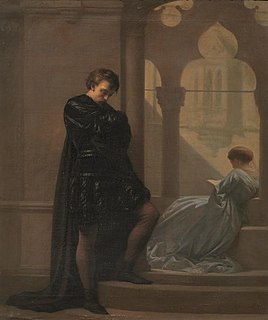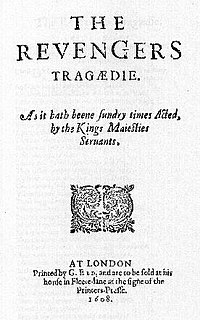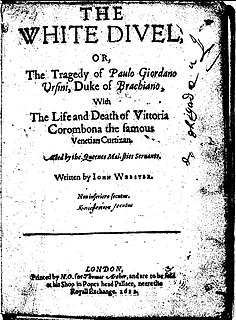
The Tragedy of Hamlet, Prince of Denmark, often shortened to Hamlet, is a tragedy written by William Shakespeare sometime between 1599 and 1601. It is Shakespeare's longest play, with 29,551 words. Set in Denmark, the play depicts Prince Hamlet and his revenge against his uncle, Claudius, who has murdered Hamlet's father in order to seize his throne and marry Hamlet's mother.

The Merchant of Venice is a 16th-century play written by William Shakespeare in which a merchant in Venice named Antonio defaults on a large loan provided by a Jewish moneylender, Shylock. It is believed to have been written between 1596 and 1598.

Shakespearean tragedy is the designation given to most tragedies written by playwright William Shakespeare. Many of his history plays share the qualifiers of a Shakespearean tragedy, but because they are based on real figures throughout the history of England, they were classified as "histories" in the First Folio. The Roman tragedies—Julius Caesar, Antony and Cleopatra and Coriolanus—are also based on historical figures, but because their sources were foreign and ancient they are almost always classified as tragedies rather than histories. Shakespeare's romances were written late in his career and published originally as either tragedy or comedy. They share some elements of tragedy, insofar as they feature a high-status central character, but they end happily like Shakespearean comedies. Almost three centuries after Shakespeare's death, the scholar F. S. Boas also coined a fifth category, the "problem play," for plays that do not fit neatly into a single classification because of their subject matter, setting, or ending. The classifications of certain Shakespeare plays are still debated among scholars.

George Chapman was an English dramatist, translator and poet. He was a classical scholar whose work shows the influence of Stoicism. Chapman has been speculated to be the Rival Poet of Shakespeare's sonnets by William Minto, and as an anticipator of the metaphysical poets of the 17th century. Chapman is best remembered for his translations of Homer's Iliad and Odyssey, and the Homeric Batrachomyomachia.

John Marston was an English playwright, poet and satirist during the late Elizabethan and early Jacobean periods. His career as a writer lasted only a decade. His work is remembered for its energetic and often obscure style, its contributions to the development of a distinctively Jacobean style in poetry, and its idiosyncratic vocabulary.

The revenge tragedy, or revenge play, is a dramatic genre in which the protagonist seeks revenge for an imagined or actual injury. The term revenge tragedy was first introduced in 1900 by A. H. Thorndike to label a class of plays written in the late Elizabethan and early Jacobean eras.
Revenge tragedy is a theoretical genre in which the principal theme is revenge and revenge's fatal consequences. Formally established by American educator Ashley H. Thorndike in his 1902 article "The Relations of Hamlet to Contemporary Revenge Plays," a revenge tragedy documents the progress of the protagonist's revenge plot and often leads to the demise of both the murderers and the avenger himself.

The Revenger's Tragedy is an English-language Jacobean revenge tragedy which was performed in 1606, and published in 1607 by George Eld. It was long attributed to Cyril Tourneur, but "The consensus candidate for authorship of The Revenger’s Tragedy at present is Thomas Middleton, although this is a knotty issue that is far from settled."
The Witch is a Jacobean play, a tragicomedy written by Thomas Middleton. The play was acted by the King's Men at the Blackfriars Theatre. It is thought to have been written between 1613 and 1616; it was not printed in its own era, and existed only in manuscript until it was published by Isaac Reed in 1778.

King Claudius is a fictional character and the main antagonist of William Shakespeare's tragedy Hamlet. He is the brother to King Hamlet, second husband to Gertrude and uncle and later stepfather to Prince Hamlet. He obtained the throne of Denmark by murdering his brother with poison and then marrying the late king's widow. He is loosely based on the Jutish chieftain Feng who appears in Chronicon Lethrense and in Saxo Grammaticus' Gesta Danorum. There has never been an actual Danish King of that name.

The Spanish Tragedy, or Hieronimo is Mad Again is an Elizabethan tragedy written by Thomas Kyd between 1582 and 1592. Highly popular and influential in its time, The Spanish Tragedy established a new genre in English theatre, the revenge play or revenge tragedy. The play contains several violent murders and includes as one of its characters a personification of Revenge. The Spanish Tragedy is often considered to be the first mature Elizabethan drama, a claim disputed with Christopher Marlowe's Tamburlaine, and was parodied by many Elizabethan and Jacobean playwrights, including Marlowe, William Shakespeare and Ben Jonson.

The White Devil is a tragedy by English playwright John Webster. According to Webster's own preface to the 1612 Quarto Edition, "To the Reader", the play's first performance in that year was a notorious failure; he complained that the play was acted in the dead of winter before an unreceptive audience. The play's complexity, sophistication, and satire made it a poor fit with the repertory of Queen Anne's Men at the Red Bull Theatre, where it was first performed. It was successfully revived in 1630 by Queen Henrietta's Men at the Cockpit Theatre and published again in 1631.

Antonio and Mellida is a late Elizabethan play written by the satirist John Marston, usually dated to c. 1599.

The Malcontent is an early Jacobean stage play written by the dramatist and satirist John Marston ca. 1603. The play was one of Marston's most successful works.

Prince Hamlet is the title role and protagonist of William Shakespeare's tragedy Hamlet (1599–1601). He is the Prince of Denmark, nephew to the usurping Claudius, and son of King Hamlet, the previous King of Denmark. At the beginning of the play, he struggles with whether, and how, to avenge the murder of his father, and struggles with his own sanity along the way. By the end of the tragedy, Hamlet has caused the deaths of Polonius, Laertes, Claudius, and Rosencrantz and Guildenstern, two acquaintances of his from childhood. He is also indirectly involved in the deaths of his love Ophelia (drowning) and of his mother Gertrude.
Lust's Dominion, or The Lascivious Queen is an English Renaissance stage play, a tragedy written perhaps around 1600, probably by Thomas Dekker in collaboration with others and first published in 1657.
The Fatal Contract: A French Tragedy is a Caroline era stage play, written by William Heminges. The play has been regarded as one of the most extreme of the revenge tragedies or "tragedies of blood," like The Spanish Tragedy and Titus Andronicus, that constitute a distinctive subgenre of English Renaissance theatre. In this "most graphic Caroline revenge tragedy...Heminges tops his predecessors' grotesque art by creating a female character, Chrotilda, who disguises herself as a black Moorish eunuch" and "instigates most of the play's murder and mayhem."
Hieronimo is one of the principal characters in Thomas Kyd's The Spanish Tragedy. He is the knight marshal of Spain and the father of Horatio. In the onset of the play he is a dedicated servant to the King of Spain. However, the difference in social status becomes apparent when his son is wrongfully murdered by Balthazar, the son of the viceroy of Portugal, and Lorenzo, the son of the Duke of Spain, which eventually causes tragic events to unfold. In order to revenge the death of his son, Hieronimo takes on additional roles, a playwright and an actor. He uses his position in the King's court to write and perform a play within a play. This performance mirrors the actual events surrounding Horatio's death, and within this show Hieronimo commits his own acts of revenge against the perpetrators. Many critics see Hieronimo as a dynamic character that by the end of the tragedy has become obsessed with taking revenge against the murderers of his son. Literature of 16th century England was greatly concerned with plots of deceit, confusion and madness as its central theme. The Spanish Tragedy is no different.












